When I wrote the article “Simple Strength for Difficult Times” I outlined an 8-week plan, confident that within two months we would be all back to our gyms and our regular life. Unfortunately, this hasn’t happened yet. Most of us are still under lockdown and many gyms all across the world are still closed.
As I’m writing this many of those who started the plan are approaching the final weeks and have already been asking me what the next steps are once completed. I actually started the plan three weeks before the article was published, and I had already been thinking for a while about potential options for a sequel.
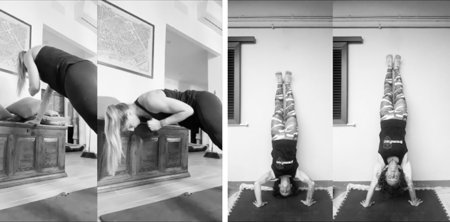
The right idea came to my mind while I was in the process of designing a plan for Kateřina Lisová, a friend from Czech Republic who is also a StrongFirst Instructor and a very accomplished fighter. To make a long story short, Kateřina discovered she suffers from a rare mitochondrial disease that no longer allows her to push her glycolytic system hard. If she does, it might accelerate mitochondrial death leading to myofibrillar disruption further compromising her skeletal muscle function.
Given her current situation Kateřina has been advised to train only in an anaerobic alactic or aerobic fashion. This means short duration, high power output, or long duration, low power output respectively and is commonly referred to as A+A training. This led her to give up competitive fighting along with some training modalities she used to enjoy, but she is an athlete with a very competitive mindset, who needs to challenge herself with a goal to be motivated to carry on her training. She’s definitely not the type of person who would ever give up.
After a team discussion with her sports medicine doctor, Jiri Dostal, Pavel, Brett Jones and, me, Kateřina decided to commit to a pure strength achievement, and choose to train for the Iron Maiden Challenge. The rest of the team are providing Kateřina with aerobic training advice aimed to preserve her mitochondrial health, I was in charge of designing her strength plan.
As you might be aware, the Iron Maiden Challenge consists in three events, the pistol, the military press, and the weighted pullup, all performed for one rep with a 24kg kettlebell. So, a squat, a press, and a pull…hmmm… As I finalized the plan for Kateřina I realized that its foundations, as far as for template and algorithm, would be a perfect fit for the sequel of the “Simple Strength for Difficult Times” plan. I had to apply several edits dictated by the sake of consistency and continuity with the previous plan, but at the end I was able to finalize the 8-week plan that I’m about to share.
I am, of course, looking forward to everyone being out of lockdown and back to their gyms and regular life—healthier and stronger than ever—long before the next 8 weeks. And as a matter of fact, this plan is also perfectly suited to regular training with a full choice of equipment.
The Plan
Like the previous plan, this one is also based upon three movement patterns: one squat, one press, and one pull. The table below presents the template of the plan, which you will have to customize according to the equipment you have at hand and your skill and strength levels.
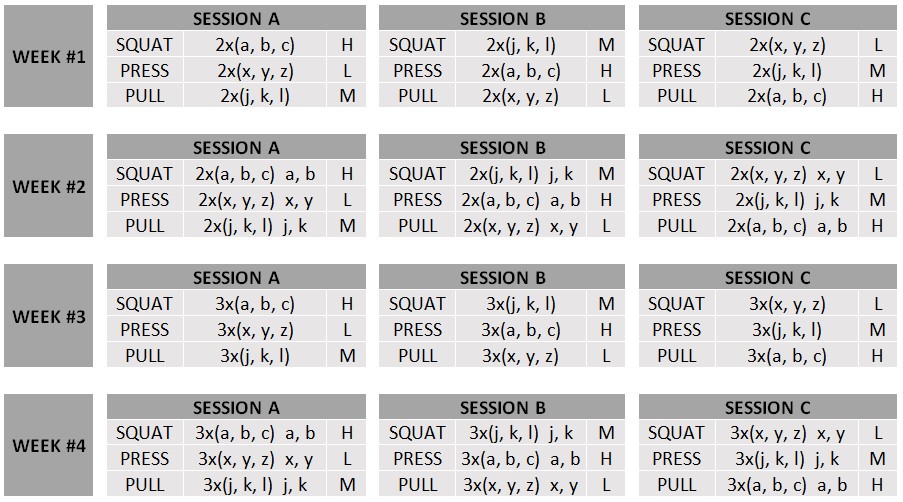
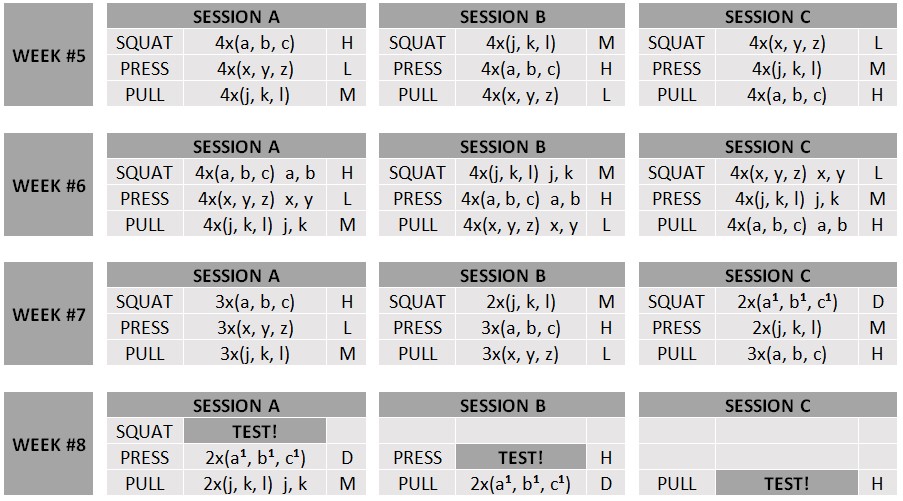
In the initial plan, you stuck to the same weights and exercises at all times and varied only the volume (number of repetitions). This phase of the plan will use not one, but three different weights, thereby varying both intensity and volume for more dramatic results. If your gear selection is limited, you could choose one or two variations in the exercise group. For example, a pullup, a chin-up, and a kettlebell row would be “heavy”, “medium”, and “light” pulling motions respectively.
How to Customize the Plan
For each one of the movement patterns, according to your strength and skill level and the available equipment, you may pick one or more kettlebell, barbell, dumbbell or bodyweight exercises. The table below presents a list of options. You might have more choices than those presented in the table, depending of the equipment you have at hand.
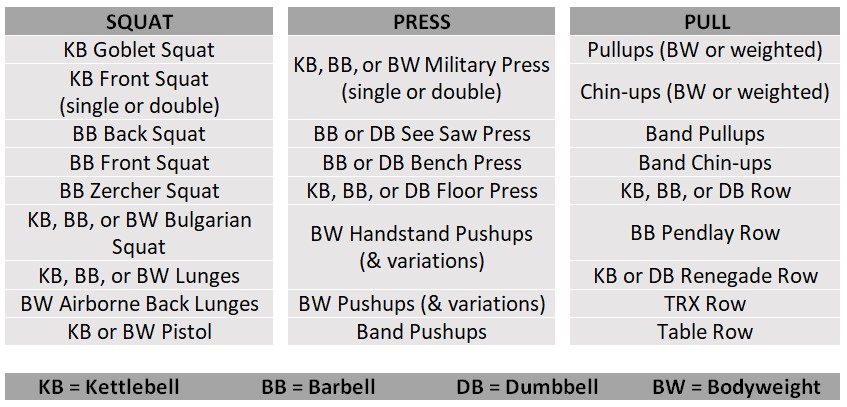
You will make your choices so that for each one of the movement patterns you will be able to train under three different intensity zones:
- 2-6TRM—Heavy
- 7-11TRM—Medium
- 12-16TRM—Light
If you are unsure about what TRM means, check this article before moving forward.
According to the list above, you will select one weight, exercise or exercise variation that allows you to complete 2-6 perfect repetitions to “technical” exhaustion, one weight, exercise or exercise variation that allows you to complete 7-11 perfect repetitions and one weight, exercise or exercise variation that allows you to complete 12-16 perfect repetitions. Just to be clear, “technical exhaustion” means your form is perfect. PERFECT. You do not dig deep and grind an ugly rep or two out and risk injury.
Here are some examples:
Mr. White has a full set of kettlebells. In the one arm kettlebell military press he can complete 5 perfect reps to exhaustion with a 40kg, 9 perfect reps to exhaustion with a 36kg, and 12 perfect reps to exhaustion with a 32kg. He chooses to always use this exercise as his press, as the weights in his possession cover all of the three intensity zones.
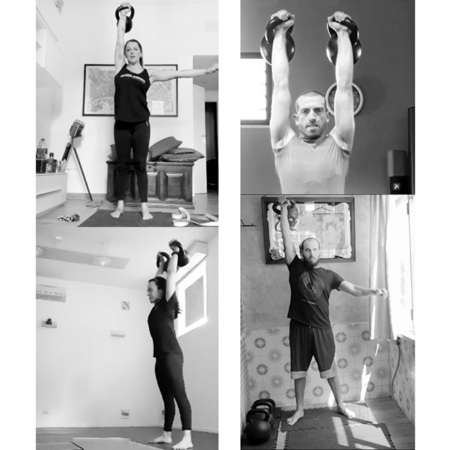
Mrs. Brown has a pullup bar and can complete 3 perfect bodyweight pullups and 7 perfect bodyweight chin-ups. She also has some kettlebells and can complete 12 rows with 16kg. She chooses the bodyweight pullup for her heavy intensity zone, the bodyweight chin-up for her medium intensity zone, and the kettlebell row for her light intensity zone.
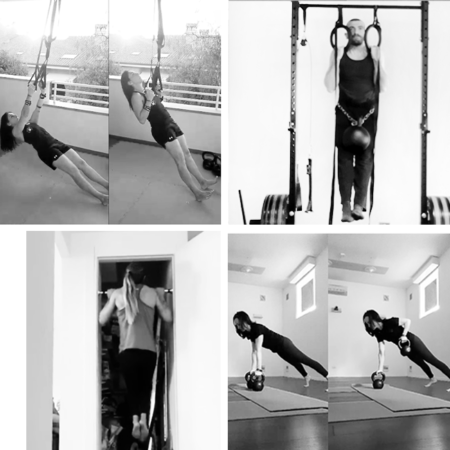
Mr. Black has double kettlebells up to 32kg, plus one 36kg and one 40kg, and can complete 5 perfect pistols with 40kg, 9 perfect pistols with 28kg and 12 double kettlebell front squats with 32kg. He can also complete 3 perfect handstand pushups, 8 perfect reps with 36kg in the one arm kettlebell military press, and 14 perfect reps with 32kg in the double kettlebell military press. Finally, he can complete 4 perfect weighted pullups with 24kg and 7 with 16kg and 12 bodyweight pullups. Mr. Black chooses the pistol for the heavy and medium intensity zones of his squat pattern and the double kettlebell front squat for the light intensity zone. He also chooses the handstand pushup for the heavy intensity zone of his press pattern, the one arm kettlebell military press for the medium, and the double kettlebell military press for the light. Finally, he picks the pullup as his pull pattern, for all of the three intensity zones.
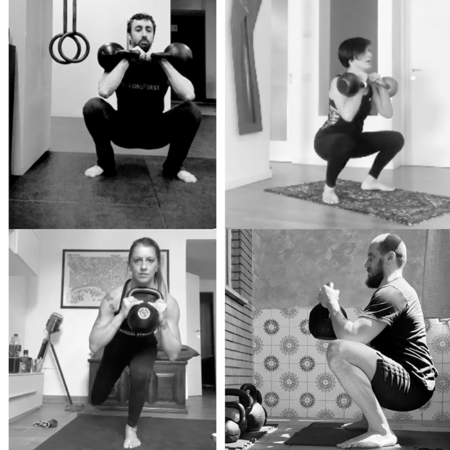
Mr. Pink…no, there is no Mr. Pink around here.
Once you have picked your exercises and weights that fit into the three intensity zones, it’s time that you select the appropriate repetition ladders. You will do that according to your TRMs and the table below.

Here’s an example with Mr. Black’s exercise choices and numbers.

Please take the time to test your TRM with each weight and exercise and/or exercise variation accurately. It will be crucial to selecting the proper ladder rep counts for the program. If you simply guesstimate them you might end up choosing inappropriate rep counts. This will lead to either your sessions to be too light to be effective, or even worse, too tough to allow you to complete them as the volume kicks in throughout the weeks.
If you have undertaken the “Simple Strength for Difficult Times” plan and you haven’t completed it yet, you may take advantage of week 8 that prescribes testing. If instead you decide to start directly with this plan, I advise that you spend the week prior to starting it to run all the required testing. Just like the setup for a lift is your first rep, setting an accurate TRM is your ground zero for this plan.
Once you have picked the appropriate ladders according to your TRMs your next step will be entering all the data in the plan template in order to turn it into your customized plan. All you have to do is put your exercise selections in place of the words SQUAT, PRESS, and PULL and your ladder rep counts in place of the letters a, b, c, a1, b1, c1, j, k, l, x, y, and z.
Here’s an example of the first two weeks of the plan for our friend Mr. Black, with his exercise selections and ladder rep counts:

(Please refer back to the table at the top outlining the overall program and note that in week 7 and 8 listed in some exercises you will have to enter the deload rep counts a1, b1, and c1.)
How to Execute the Plan
The three exercises are to be executed in a slow-circuit fashion. This means that you will do a set of the squat of your choice, shake off the tension, take some rest, do a set of your chosen press, shake off the tension and rest, and do a set of your chosen pull. Once you’ve done all that above the round is over, and you will take a longer rest before you start the next one.
You should make sure that you rest no less than 1-2 minutes after the sets with the lower and medium rep counts, and 2-3 minutes after the sets with the higher rep counts. Once you have gone through the three exercises you may rest more than 3 minutes, before you start the next round.
For instance, let’s say that Mr. Black is about to start Session B of week two of his plan, with the exercises of his choice which I have listed above.
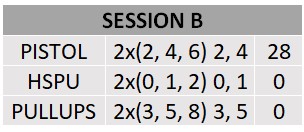
His session would call for two ladders of 2, 4, 6 plus one ladder of 2, 4 for the pistol; two ladders of 0, 1, 2 plus one of 0, 1 for the handstand pushup; and two ladders of 3, 5, 8 plus one of 3, 5 for the pullups.
Here’s how he would do it:
Ladder one, Round one
- Pistol—2 reps per side
- 1-2 minutes rest, including fast and loose drills
- Handstand pushup—0 reps, so he will skip it for this round
- Pullups—3 reps
- 3 or more minutes rest, including fast and loose drills
Ladder one, Round two
- Pistol—4 reps per side
- 1-2 minutes rest, including fast and loose drills
- Handstand pushup—1 rep
- 1-2 minutes rest, including fast and loose drills
- Pullups—5 reps
- 3 or more minutes rest, including fast and loose drills
Ladder one, Round three
- Pistol—6 reps per side
- 2-3 minutes rest, including fast and loose drills
- Handstand pushup—2 reps
- 2-3 minutes rest, including fast and loose drills
- Pullups—8 reps
- 3 or more minutes rest, including fast and loose drills
After adequate rest, he would repeat for his second ladder. Once these two ladders are complete, the job isn’t done yet. There are still two rounds left, the first one consisting of two pistols per side and three pullups, and the second of four pistols per side, one handstand pushup, and five pullups.
Weekly Schedule, What to Do on Alternate Days and Testing
The same suggestions and guidelines I provided for the plan in the previous article also apply to this one, and you may check them here.
With regards to testing, in addition to retesting the exercises you performed throughout the plan, you might want to test some others, and note any carryover to other skills, which is what we call the “What the Heck?” Effect.
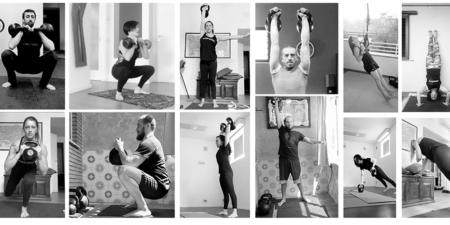
Conclusion
Both this program and its predecessor may be followed as stand-alone plan or can be combined into a 16-week plan.
Whether you decide for the former or the latter option, once you have completed you may repeat the cycle a second time. And you may do it either with the same exercise selections, simply plugging in new TRMs according to the results of your testing week, or with new exercises and their related TRMs that you will have to test. After all, getting stronger has less to do with the exercises, and more to do with the principles. And the principles that rule Strength are universal, no matter the exercise variation or the tool that you are using.

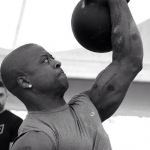

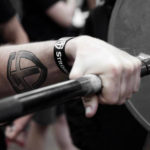


Hey fabio, hope you dont mind my question is based of the article Simple Strength for difficult times PART 1. I’m a pretty a hungry student.
I have 4 conundrums.
I recently learned my max on bodyweight pull ups, with perfect form, is 6.
Question 1. Could i the tailor the last exercise in the ladder( pull-ups) specifically for strength so I can increase the reps so i can get them up to the 8-10 TRM. If so what would the reps be and in what order?
E.g. 1,3,1- 1,2,3…?
If not what other exercise would you recommend–that might also help me get my pull up reps up if possible– that I do? Please note that i have access to one 12 kg KB and one 22 kg KB and mainly bodyweight exercises.
Question 2. Can I do heavy swings and Turkish get ups on alternate days, and when I say “heavy” i with a heavy weight where my max TRM is 5-7.
Question 3. Would assisted handstand push-ups be an acceptable exercise for a press in the ladder? Just until I work up to complete handstand push-ups. Assisted handstand push-up being i’m in the shape of a slanted L, a 90 degree angle. My upper body is mimicking the form of handstand and the movement of a handstand push-up, but legs and toes are mimicking the form and balance of a regular pushup.
If no, what would you recommend?
Question 4. My legs have always had mass but not my calves. Can I change the leg setup of the routine to focus on making my legs stronger not bigger, while adding calf work to the routine to place emphasis on growing stronger, bigger calves? If so, what would the set up look like?
Fabio, as always, thanks for the impact you have and your very helpful counsel. CARRY ON NOBLE SPARTAN!!!
In fact if you have a tip to slim my legs down a little, and if you could recommend how to keep them lean and strong for the long haul, that would be awesome.
Every where I look on YouTube or the internet I see advice that’s clearly hypertrophy centric and conflictive with actual common sense for leaning down.
Would appreciate your imput. Thanks Fabio.
If with “a tip to slim my legs down a little” you mean training them in order to increase their strength without leading to muscular hypertrophy, then the answer is selecting the exercise variation or the weight in order to stay always on the lower end of the rep range for each intensity zone. You can also eventually avoid the sets of the ladders with the highest number of reps. So for instance, if the ladder calls for 2, 4, 6 you may do 2, 4, 4 or 2, 4, 2 instead.
If instead with “a tip to slim my legs down a little” you mean losing fat, that’s more a matter of nutrition and aerobic work done on alternate days.
Hi Tre,
I think I made some mistakes in the attempt of using HTML codes to create some quotes…. I hope the answers below will help clarifying.
Question 1:
I suggest that you train the squat and the press with the STDT plan and do something different for your pullups. Some great ideas are in the articles below:
https://www.strongfirst.com/the-fighter-pullup-program-revisited/
https://www.strongfirst.com/how-to-increase-your-pull-ups-50-percent/
https://www.strongfirst.com/who-says-women-cant-do-pullups/
Question 2:
Yes! Explosive swings in sets of 5 with generous rest intervals between sets and get-ups for singles up to a total of 10 (5 per side).
Question 3:
Assisted handstand pushup are definitely a good option.
Question 4:
I know hundreds of bodybuilders who have tried to add some mass to their calves with poor results, while I don’t know sprinters whose calves are lacking in muscle mass. This can be already considered one training tip, LOL. In any case, first I would assess ankle mobility. If there is poor range of movement there then it’s hard to build muscular calves. If that is the case the first step is to work on ankle mobility. Then one leg standing calves with straight knee and balls of the foot on an elevation in order to guarantee maximum range of motion are one good choice. Also repeats of short sprints uphill will deliver. Finally, Romanian deadlifts with balls of the feet on a slight elevation will help.
Fabio, as always you are a freaking spartan!
Thanks man.
I will take this to the heart and will for sure let you know my results.
Take care.
What is the rationale behind Simple and Sinister on the alternate days? How does this augment the lifting days?
Hi,
Simple and Sinister on alternate days was my choice for my own training and just a suggestion. One may choose to do the same or something else or simply stick to the 3 sessions/week plan.
It’s not meant to augument the lifting days, but to add some variety and train other qualities. Take into consideration that the plan was designed for the time in which most of us were under lockdown and our lives became very sedentary.
I hope this explains.
If one can tolerate, would you recommend adding more lifting sessions in the week?
I wouldn’t do it for this plan as it is. It should be tweaked appropriately in order to make it fit for more than three sessions per week.
Thanks for that tip. Will stick to the plan and hope to see the gains.
Hello, I just completed the program and wanted to shared my results.
Lift – Before – After
Low bar hex bar deadlift : 185# X 5 -> 185# X 12
Rind dips : BW + 32# X 6 -> BW + 32# X 12
Rock rings pull-ups : BW + 32# X 5 -> BW# + 32 X 10
I also lost 7 pounds, I am really happy with the results and will start another cycle next week.
Thank you Fabio for this great program !
Hi Maxime!
Those are really impressive results, you doubled all of your RMs!
And also lost 7 pounds… awesome!
What did you do on alternate days?
Hi Fabio!
on off days, 3 times a week I ran sprints in an anti-glycolytic manner . I did low, medium, high volume days, keeping the high volume day just before my day off. I enjoyed it, but for the next cycle I will decrease the volume of sprints in between the strength days when the ladders reach more than 3 rounds, to be sure to recover enough.
Hi Maxime,
I like what you did and I like your plan of decreasing the volume of sprints as the volume of the strength plan kicks in.
Great job, Sir!
Hello Mr Zonin,
thank you very much for this informative article.
Actually, this regiment was the very first I was motivated to follow after several years of un-planned training sessions.
I am im testing week currently, and I will update on friday, when the cycle ends with the pull test. So far, I am very satisfied with the results.
Having applying the ladder-method for the first time, I was wondering, if the same could be applied to time/distance based exersices, like sprints or loaded carries. May I ask, could this possibly work out? Is there a way to allign the max. distance of a farmers walk or the max time of a sprint with the above mentioned TRM and its according tables?
Again, thank you.
Best regards,
Marcel
Letting the numbers speak now
[Exercise][OLD TRM] [NEW TRM]
Squat
[Skater Squat +12kg][4/3][9/8] +167%
I only did those on the HEAVY DAY. Other Days I sprinted and/or played with Deadlifts
Push
[Double 22.5kg Dumbell OHP ][5][10] +100%
[Ring Dips][8][13] +63%
[Feet elevated Push Ups][15][21] +40%
Pull
[Chinups +20kg][3][6] +100%
[Ring Rows][10][14] +40%
[Double 22.5kg Dumbell Row][13][21] +62%
I recognize some body composite improvements (became leaner while subjectively gained muscle). I guess eating more would have been resulted in a pretty decent muscle gain.
The program became more exhausting as the weeks passed by, although I was never really sore and still felt powerful for the challenges of the day. Also, most of the workouts I absolved within 30 minutes or less (yes, I shortened the rest periods often).
I think I will go for another round 🙂
Thank you.
Marcel
Hi Marcel,
Your results are impressive, Sir!
“I recognize some body composite improvements (became leaner while subjectively gained muscle). I guess eating more would have been resulted in a pretty decent muscle gain.”
Yes, body-recomposition si one of the WTH effects of the plan.
“The program became more exhausting as the weeks passed by, although I was never really sore and still felt powerful for the challenges of the day. Also, most of the workouts I absolved within 30 minutes or less (yes, I shortened the rest periods often).”
Yes, and week 6 is the toughest one.
“Having applying the ladder-method for the first time, I was wondering, if the same could be applied to time/distance based exersices, like sprints or loaded carries. May I ask, could this possibly work out? Is there a way to allign the max. distance of a farmers walk or the max time of a sprint with the above mentioned TRM and its according tables?”
I have personally never experimented with this, but it makes sense and I believe it would work. I will explore the option and will probably be able to come up with some guidelines (and possibly tables) in the future. Thank you for giving me the idea.
Thank you very much for your answer.
I tried to find some detailed Information to this specific topic (time to rep correspondence), unfortunately yet unlucky.
But my backround and experience aren’t even near yours levels by any means. So I would be very happy to read something from you about this.
Until then, I will just go and run as I feel and have fun doing so 🙂
With best regards
Marcel
I had started on a KB only version of your previous hypertrophy program which you put together for your competition. It has been quite fun so far. However, I am wondering which program you would recommend if the focus if functional body building between that previous program or doing this one with the modification you suggested of choosing above addressing Jérôme’s question.
“The easiest way to do it is select your exercise variation in each repetition range in a manner that it’s on the top of it. So 6RM in the 2-6TRM zone, 11RM in the 7-11TRM zone and 16RM in the 12-16TRM zone. This alone will lead to more muscle gains.”
Thanks so much for sharing your insights.
Hi,
This second version will certainly turn out to be very effective for functional bodybuilding goals, especially if your exercise variations and weight choices fall into the top reps of each zone.
However, for a plan that aims specifically to functional bodybuilding, I would suggest s Built Strong BTS6 plan. Those plans are not available yet, as the only way to learn about them is by attending a Built strong seminar (the very first one happened a few weeks ago, and we’ll schedule more soon). However, we are working behind the scenes on a Built strong Custom Plan service, which should be available soon.
Thank you so much for your advice. I will plan on switching over from your modified KB only hypertrophy program to this one targeting the higher reps. This sounds like fun!
I look forward to the Built strong Custom Plan service. Please fo let us know when it is available.
Thanks for all your great work. I was wondering if you could recommend either the first or second plan based on my current set up and goal:
– I am nearing completing a Soviet based Strong First strength program where I was focusing on Bench Press and Zercher Squat as my key lifts.
– I am 53 y/o and have been a life- long lifter and athlete with a pretty good home gym complete with an adjustable kettlebell up to 70lbs, Olympic bench and squat rack with about 350lbs of weight.
– my primary goal is strength but I certainly wouldn’t mind some muscle gain.
I was planning to use the first program (and would like to include the BB deadlift) – if so should I substitute the squat or the pull for the deadlift, or do you think this newer plan would be more appropriate?
Thank you, Jim.
Given that you are coming from a plan that included the Zercher Squat, how about starting the first plan with deadlifts in place of the squats?
Your deadlift should enjoy the benefits of the Zercher squats you did in your first plan.
And once you have completed the first plan you may run the second one and keep the deadlift in the 2-6TRM—Heavy zone and re-enter the Zercher squat in the 7-11TRM—Medium and 12-16TRM—Light zone.
I believe it can be a very interesting and effective option.
Thank you Fabio for sharing this program! I’m four weeks in and really impressed with the thoughtfulness of your design. The formula you’ve provided for calculating the reps has worked perfectly for most lifts, but I’d like to share one specific area where you might want to consider tweaking it.
I’m doing the program with my girlfriend and we found that for heavy days, when our TRM was tested at 2 or 3 reps, having sets of zero reps is unnecessary.
For example, I tested my kettlebell overhead press TRM at 5 right and 3 left with 36kg. My weighted chinup TRM was tested at 3 reps. My girlfriend had a TRM of 2 reps on 28kg kettlebell rows.
For weeks 1-2 , we ran the program as written, with sets of (0, 0, 1) for the 2 TRM exercise, and sets of (0, 1, 2) for the 3 TRM exercises. My girlfriend felt the sets of zero were unnecessary, and since she was able to execute the lifts with perfect form, I reluctantly agreed to try replacing the sets of 0 with sets of 1 rep.
To my surprise, both of us have had no problem completing all of the sets in this fashion for weeks 3 and 4. The difference in reps is significant. In week 4, she completed 11 reps of 28kg rows, compared to 3 reps, if going by the formula. On the 3 TRM exercises, in week 4 , the difference was 14 reps, versus 10 reps.
We’ve found that this program works very well in an I go, you go fashion, even though the rest periods may be less than ideal. Because of the periodization of the exercises in low, medium, and higher rep ranges, we’ve found that our strength is still adequate, when doing the circuit with a more compressed rest period, though our heart rates stay a bit higher than in a typical strength workout.
Overall this has been one of the best programs I’ve ever tried and I’m really excited to measure our progress when we test in a few weeks. You’ve created a masterpiece with this program.
Hi Elliot,
Thank you for your very kind words of appreciation on behalf of the program, Sir.
“I’m doing the program with my girlfriend and we found that for heavy days, when our TRM was tested at 2 or 3 reps, having sets of zero reps is unnecessary.”
I have to say that I agree with you, at least partially. I would say that for some the sets at 0 reps are unnecessary, while they are a wise choice for others. It depends on several factors, one of them being the individual tolerance to high volumes with weights that are in the 90%1TRM and above range. Some tolerate fairly high volumes in that zone and some don’t. For instance, probably due to my age and long list of past injuries, I belong to the latter group. For me, sets of 0 reps are a wide choice. For that above, in the process of writing an article aimed at a broad population, I opted for the most cautious and safe choice, hence I prescribed the sets of 0 reps. I hope this explains.
“We’ve found that this program works very well in an I go, you go fashion, even though the rest periods may be less than ideal. Because of the periodization of the exercises in low, medium, and higher rep ranges, we’ve found that our strength is still adequate, when doing the circuit with a more compressed rest period, though our heart rates stay a bit higher than in a typical strength workout.”
Yes, I have been also doing some sessions in the I go, you go fashion with my training partner and it worked very well.
“Overall this has been one of the best programs I’ve ever tried and I’m really excited to measure our progress when we test in a few weeks. You’ve created a masterpiece with this program.”
Thank you so much, Sir!
Hello Fabio,
First of all, congratulations for your programs and your great availability.
How can Imodify your program for (more) hypertrophy ?
I train just with bodyweight. I’m interesting with fonctionnal hypertrophy.
Have you written book(s) about this subject ?
Thank you.
Jérôme
Hello Jérôme,
First and foremost, thank you for your very kind words.
“How can Imodify your program for (more) hypertrophy ?
I train just with bodyweight. I’m interesting with fonctionnal hypertrophy.”
The easiest way to do it is select your exercise variation in each repetition range in a manner that it’s on the top of it. So 6RM in the 2-6TRM zone, 11RM in the 7-11TRM zone and 16RM in the 12-16TRM zone. This alone will lead to more muscle gains.
“Have you written book(s) about this subject ?”
Nothing published yet, but I’m working on one. In the meanwhile, I teach an online seminar that covers how to design functional hypertrophy plans. The seminar is called “Built Strong” and I’m teaching one this weekend. Here’s the link for more info: https://www.strongfirst.com/special-events/second-wind-express-built-strong-information/
I hope I was helpful
Hello Fabio,
Thank you very much for your answer.
All the best,
Jérôme
Any more online seminars on functional hypertrophy?
Do deadlifts have a place in the plan? If so, how would you integrate them? Thank you for your knowledge. I’m 2 weeks in and enjoying it!
Hi Fabio
Thanks for the great plan. I’m testing TRM’s this week and starting next week. Out of curiosity, does deadlift have a place in the program? There is no version of DL listed in the sample lists of exercises.
Hi Shawn,
Actually there are two reasons for which I did not include the deadlift or another hip hinge.
1. In the article I suggest swings or snatches on alternate days and that covers the hip hinge pattern
2. Since the plan was designed for home training during quarantine I looked into exercises that can easily be done with home training equipment. Not many have a barbell at home and even a pair of heavy bells might not be sufficient for the heavy deadlift day.
That said, if you have a barbell available and you wish to do deadlifts in place of squats, that’s totally doable.
I hope you will find my answer helpful.
Makes sense. Much appreciated!
Thank you for this amazing program !
I made a google sheet out of it if anyone is interested : https://docs.google.com/spreadsheets/d/1FJLODlM8LIOmJAysDCJutF846Vr-rv4hN9Yyp1N4Zwk/edit?usp=sharing
Just copy to your drive and input the correct values in the exercises, reps, weight cells.
Have a nice evening !
Perfect. Thanks a lot for the spreadsheet!
Wonderful job, Maxime! Thank you for sharing!
Fabio – I can certainly work through a plug and play version (and will post it here for all to use), but before doing so – I wanted to ask if you have the program available (since it looks like it may have been converted) through Google Sheets or Excel by chance?
Hi Jay,
Actually I did create an excel that generates the plan automatically according to the exercise selection and the RMs, but I don’t know how I could upload it here.
Thanks for this great article Fabio. Quick q – would it be possible to do let’s say Session A on Saturdays, Session B on Sundays and Session C mid-week?
My work schedule is hectic during the week, so I would train more relaxed/focused on the weekend, but a back to back session would not be recommended.
Thanks again!!
Hi Frederico,
Yes, it’s definitely doable. Ideally, sessions should be separated by at least by one day of rest, but we have to the best with what we have, right? And a session on Saturdays, one on Sundays and one mid-week is much better than no session 😉
Great article Coach Zonin!
Wanted to bring to your attention the typo in the main table in the article, the parenthesis on the low threshold days, is written (x, y, x) whereas the spreadsheet and later examples state (x, y, z)
Strength and health to all.
Firas
Thank you, Firas!
And thank you so much for catching the typo (oooops!). I will ask our website revisor to have it fixed ASAP.
Strength and health to you also!
Fabio
Nice post. I was checking continuously this blog and I am impressed!
Very helpful info specifically the ultimate part 🙂 I take
care of such info much. I used to be seeking this particular information for a long time.
Thank you and best of luck.
Thank you so much for your very kind words of appreciation, Yasmin.
Hi Fabio!
Thank you very much for this info, I have a doubt; if I´m currently on the fighter pull up program, I still can fit this routine of legs, push and pull? Or should I only ad the push and leg exercises? (the pull that I would choose is some row).
Thanks again bro.
Hi Ivan!
You may definitely use this routine for your squat and press and carry on your Fighter Pullup Program.
I would be very happy to receive your feedback once you have gone through the plan tweaked in this manner.
Hi Fabio,
thank you very much for sharing these plans.
I did not find the push press as an option for presses. Is it a valid option? With the weights available I tested 4TRM of push-press with my 1RM military press. So, I would like to use this movement as the heavy day for the press, but I wonder if Fabio did not listed is for a good reason.
Thank you again for your plans (I have finished a round of Re-loaded before lockdown, I just realized that you are like my PT lately…)
You are very welcome, Leonardo!
And you are right, there is one reason for which I did not put the push press among the options. I may excuse myself by saying that I have specified in the article that one might have more choices than those I have listed, but the reason is simply that I didn’t think about it when I wrote the list. So the push press is welcome!
Honored to be your PT!
Thank you Sir!
Coach Zonin,
I am in my testing week of Part 1 (Goblet squat, KB press, BW pull up) I am planning on beginning part 2 (same movements) and was using this testing week to establish my TRMs.
I’m looking for some guidance on how to get these three TRMs in the most efficient and effective manner preferably on one day.
Any and all guidance is appreciated.
Thank you.
Hi Joseph,
I will give you an example with you KB military press.
Once you did your warm-up in the way you are accustomed to (just don’t get tired), you should ramp up with easy doubles and singles to the weight with which you believe you can perform 3-6 reps. Take plenty of rest between ramp up sets (I would say no less than 3 minutes), as you want to be fresh when attempting your TRM. Then test your TRM. Count only the perfect reps! Your TRM will be that one of your weaker side. So if you complete 6 reps with your right arm and 5 with your left, your TRM will be 5. Now you have your weight and TRM for the heavy sessions. Take a long rest (no less than 5 minutes) and test with a lighter bell for the 7-11TRM for your medium sessions. Repeat the process for your light 12-16TRM for the light sessions.
When you test for your 3-6TRM, if you end up completing less than three reps, then take a long rest (no less than 5 minutes) and test your 3-6 TRM with a lighter bell. If instead you complete more than 6 reps and less than 12, then keep that as your medium weight, take a long rest, and attempt with a heavier bell for the 3.6TRM. Finally test for your 12-16TRM.
I hope this helps.
Thanks coach!
Big help.
Love the program.
I’ve shared it with many of my military doctor colleagues. Rest assured you’re making the front line stronger during this pandemic.
Respectfully,
Joseph
You are very welcome, Joseph!
I am honored to hear I was helpful to the heroes in the front line during the pandemic.
Hi, Fabio… would you test all three movements on the same day?
Hi Tim,
You mean the initial tests for assessing the RMs before you start the plan, correct?
If yes, you can test them all on the same day. I suggest that you start testing with the heaviest exercise for each movement pattern and proceed downwards. Once you have done testing for one movement, start over with the next one. I also suggest that you rest no less than 10 minutes between attempts.
I hope this helps.
Fabio
Thanks!
I’m almost done. I’m in the middle of week seven. I see on week eight the testing is done, but one movement each session. Would it still be the same sort of process – warm up – singles, etc… and then test the heavy weight?
Hi Tim!
“Would it still be the same sort of process – warm up – singles, etc… and then test the heavy weight?”
Yes, exactly.
Fabio, thank you!
This is outstanding!
Run a 16-week cycle with A+A on alternate days, then 6 weeks of Q&D, 2 weeks of some glycolytic peaking to shed off cellular debris, a week of resting, celebrating, and testing for the next cycle. Repeat two times and you’ve got the whole year covered with couple of weeks spared for vacation. One can live on it for the rest of his/her life. Awesome!
Wow, I love the way you laid down the yearly plan!
Thank you so much for your very kind words of appreciation, Alexey!
Coach Fabio,
Thank you very much for puting this plan, it’s something that personaly I was searching for a long time.
Alexey may I ask you what would you recommend as “glycolytic peaking”? The yearly plan you suggest is amazing.
Very pleased to see this follow-up article Fabio, thank you. I appreciate the work and thought that has gone into it.
I’m in the testing week of the first programme now – my 24kg KB press has gone from 3 reps to 10 good reps, so I’m pleased.
I like the variety of exercise but also the waving of intensity in this new programme and am looking forward to getting into it.
I think I’ll have to start training outside so I can get to the pull-up bar and back easily instead of up two flights of stairs!
Hi Benjamin!
“Very pleased to see this follow-up article Fabio, thank you. I appreciate the work and thought that has gone into it.”
Thank you, Sir!
“I’m in the testing week of the first programme now – my 24kg KB press has gone from 3 reps to 10 good reps, so I’m pleased.”
Wow, this is an impressive result!
“I like the variety of exercise but also the waving of intensity in this new programme and am looking forward to getting into it.”
I’m so glad to hear you like it!
“I think I’ll have to start training outside so I can get to the pull-up bar and back easily instead of up two flights of stairs!”
If the weather is stable and good, that’s a good option. On my side I’m still going up and down the stairs in order to reach my pullup bar…
Thanks again…if I have a KB selection or movement that would allow me to be at either at the low end of reps or high end reps for each of the H, M, L, is there a preferred approach? Ex: I could do a 16kg weighted pull-up for 6 TRM or a 20kg for 2 TRM for the Heavy lift.
Oh, and nice IG post of your PR on the pistols!
Hi Josh,
The main reason why one may use different weights OR/AND select different exercises is provide enough options to allow everyone to follow the plan.
For instance a friend of mine does KB press for the heavy and medium days and pushups with a band (placed in order to add resistance) for the light day.
His wife does bodyweight pushups for her heavy day, and KB press for the medium and light days.
Have you considered a 16kg weighted pull-up for the medium day and a 20kg weighted chin-up for the heavy day? Usually one can do more reps in the chin-up that in the pull-up.
I hope this helps.
Thanks Fabio, appreciate the follow-up (I apologize for missing your response). Coincidentally I actually chose Rows (L), Pull-up (M), and Chin-up (H). At completion, I clearly had improvements – not as significant as Part I improvements – happy nonetheless.
I should have just stated in the question but the basis of the question was hypertrophy vs. strength as I’m learning about the differences. And if being at the high end of the rep range would lean towards more hypertrophy.
Thanks again!
P.S. anxiously awaiting a future Built Strong event or perhaps even a book 🙂
Thank you!
I’m on week 8 of part 1 and I’m loving it! I was planning on repeating the part 1 programming, but this looks very interesting so I’m going to use this week to test for exercises for part 2.
Question: Is it better to mix up the exercises or stick to the same exercise, e.g. should I BB bench press H, M, L or is it better to bench press H- and L-days and KB overhead press M-days?
Hi Jesper,
I’m happy to hear that you are going to give a shot to this new plan.
As far as for the exercise selection, the answer is “yes!”
First of all it depends on the options you have available. For instance, the heaviest bell I have available at home (gyms are still closed here) is 40Kg. This forces me to stick with the pistol for H and M days, while I can do double kettlebell front squats for my L days.
But if you have full equipment available you have the choice. And this is a personal one that depends also on your goals. You may choose different exercises because you love variety, or because one can improve a weakness in the other. Or you may choose to stick to the same exercise for the sake of more practice that will allow you to refine your technique.
I hope I was able to answer your question.
Thank you, Mark!
Hi Fabio,
This is fantastic, thank you.
I’m half-way through part one and loving it. Doing goblet squats, feet elevated push ups and pull ups. Running it as suggested on alternate days with S&S (using a mix of 32 and 40 kg) and it seems like a great balance of volume and recovery.
Question: I’d like to move on to this part two program next, but was hoping to run it concurrently with three days of Q&D 033. Was thinking ring dips and KB press but skipping a third push because pushups is a major component of Q&D. Is that sensible or can I do a third push with this program plus the Q&D power push-ups?
Thanks again Fabio and stay safe!
Thank you so much for appreciating the plan(s), Sir!
A few options for you (I’m thinking out loud here):
1. Do the Q&D snatch protocol instead of the swing & power-pushups one.
2. Do the Q&D snatch protocol instead of the swing & power-pushups one, but apply it to the one-arm swing instead of the snatch.
3. Use only KB military press in the strength plan with three different KB sizes (so skip the ring dips) and match it with the Q&D swing & power-pushups plan.
What do you think?
Great suggestions. I did the Q&D snatch protocol a couple of months ago so was hoping to try the PU/swing version next. So I’ll probably try the 3rd option.
Thank you so much for taking the time to reply Fabio!
Would it be possible to run the snatch protocol but with heavy two hand swings?
Yes, of course.
Can you explain option 3 a little more? Q+D on one day then the simple strength program (with 3 different KB sizes for press) the next day? So alternating days for Q+D and Simple Strength? Thanks!
Hi Jack,
Of course!
I will explain it with an example:
SSDT = Simple Strength for Difficult Times
Monday: SSD (Heavy Squat, Light Press, Medium Pull)
Tuesday: Q&D
Wednesday: SSD (Medium Squat, Heavy Press, Light Pull)
Thursday: Q&D
Friday: SSD (Light Squat, Medium Press, Heavy Pull)
Saturday: Q&D
So yes, three different kettlebell sizes for the press, but not on the same day. Light on Monday, Heavy on Wednesday, Medium of Friday.
I hope I was able to clarify.
Well this is exciting! really greate article and excited to try it! Well done.
I have one question about the mentioned “deloads” sets and reps, are these done with the working weight or should the weight be lowered? Apologies if you have already written about this in the article but i couldnt find the answer
Stay Safe, stay Strong!
Thanks
Ben
Thank you, Ben!
You are right, probably I should have been more clear on this in my explanation in the article. I apologize.
You should use the same weight (the one in the 3-6TRM range). The deload ladder has lower rep counts than the regular one, and that ensures that you will get enough recovery prior to testing.
Perfect, thanks man 👍
This looks brilliant! Very interesting programming, in particular the different ladders according to different intensities and TRMs. Thanks a lot for sharing and take care!
My pleasure!
Thank you, Sir!
Thanks Fabio, super excited! I just finished Part I on Sunday and saw fantastic results in my press, which was a weighted push-up with my 9 yr old as the weight on my back – fun for the whole family :). My pull and squat increased but not as much (potentially my fault for not dialing in my pre-testing to optimize results). I actually have spent the last 2 days calibrating for Reload (but with kettlebells) and finding that it was difficult based on my KB selection and strength. Thanks again and stay healthy.
Hi Josh!
I’m so glad to hear about your results. And yes, since Reload is more of a barbell plan, it’s hard to adjust the weekly jumps to the different kettlebell sizes.
I look forward to hearing about your results with this plan!
Gonna read this a couple of times but this is an excellent sequel.. Well done Fabio
Thank you, Mark!